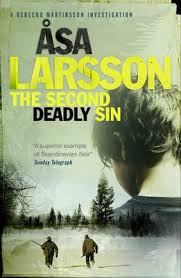The Second Deadly Sin - Åsa Larsson
S o here we are, then, at Rebecka Martinsson Investigation number five. The Second Deadly Sin, by Åsa Larsson. This is kind of a big deal. It won the Best Swedish Crime Novel Award of 2012. The five Martinsson books have amassed 1.5 million sales worldwide.
o here we are, then, at Rebecka Martinsson Investigation number five. The Second Deadly Sin, by Åsa Larsson. This is kind of a big deal. It won the Best Swedish Crime Novel Award of 2012. The five Martinsson books have amassed 1.5 million sales worldwide.
I’m a bit late to the Martinsson novels, having never read any of the previous four, but I can assure you the blurb knows the difference between a reindeer and a bear when it sees one:
At the end of a deadly bear hunt across the wilderness of Northern Sweden, the successful hunters are shaken by a grisly discovery.
Across in Kurravaara, a woman is murdered with frenzied brutality: crude abuse scrawled above her bloodied bed, her young grandson nowhere to be found. Only Rebecka Martinsson sees a connection.
Dropped from the case thanks to a jealous rival, she now stands alone against a killer who brings death to young and old, spawned by a horrifying crime that festers after one hundred years on ice.
I thought The Second Deadly Sin a slick piece of work, and a very diverting read. Larsson has a sympathetic and often arch narrative voice, and the translation is as crisp and fragrant as a fallen pine cone in the forest. Despite the shocking crime at the heart of it, it’s a good-natured novel with a lot of heart and a lot of fresh air.
Larsson’s protagonist District Prosecutor Rebecka Martinsson is a terrific lady by all accounts – but perhaps a little too terrific. She’s good-looking, successful and enjoys the outdoor life – she’s got a river view and a sauna out back – but she also makes moonshine. Hell, she’ll even smoke a cigarette with you if it puts you at ease. There’s a successful lawyer boyfriend in the city, and a kindly dog-handler who’s desperately in love with her.
Content in the wilds of Lapland, she seems to float above the messy urban concerns that trouble the rest of us, which gives her time to ponder death before breakfast, in the Nordic fashion. When Martinsson is taken off the case, she gets angry and determined to the get to the truth.
However, I prefer my protagonists, and my crime fiction - and this is a personal preference - a bit more messy and flawed. Martinsson’s copper friend Anna-Maria Mella has a bit more life to her: she’s a lonely character with a chaotic family. And I loved von Post. He’s Martinson’s bête noir, an arrogant prosecutor who gets her taken off the investigation so he can grab the glory. Of course, he’s a blundering fool and everyone loathes him – calling him von Pest - but he’s got a bit of bite, a bit of edge, to him. I’d happily read a series of books about this self-serving fool.
There’s one moment where Martinson comes to life, and it’s a genuinely shocking and interesting moment – pet-lovers with an internet connection may not agree – but in general she remains a touch too good to be true. Fair enough, this is the first Martinsson book I’ve read, so there may be a bit of context that I’m missing.
What I Liked: These parallel storylines are all the rage at the moment. My goodness, every crime novel seems to have one. So, as well as the present-day investigation, there’s a narrative that takes place before the First World War. Elina Petterson is a schoolteacher who moves to Kiruna and falls in love with the local miner manager, a self-absorbed bigwig called Hjalmar Lundbohm. Big mistake!
In this story, set in a more restrained time, the emotions simmer and rumble beneath the surface in a hugely satisfying way, and, of course, the story inevitably folds into the modern-day investigation. Not for the first time in a novel, I found myself enjoying this diversion more than the central narrative.
If you’re planning on writing a series of novels about the same character, these parallel stories, set far away or in the past, are a good way of flexing the writing muscles and injecting more mystery and atmosphere into your novel.
Many thanks to the MacLehose Press for the review copy of The Second Deadly Sin.

